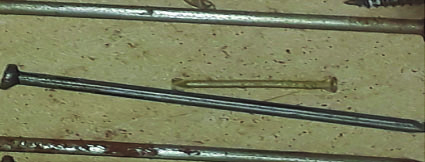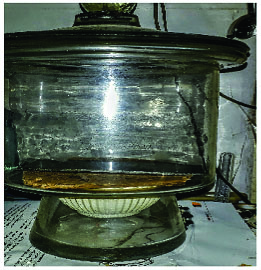Mayank Rawal
Director Technical,
Asian Laboratories
Corrosion of steel embedded in concrete is one of the major causes of degradation of concrete structures. In the marine environment, the steel bar protected by passive layer is easily attacked by the chlorides which can penetrate through the concrete cover. When the concentration of chlorides on the surface of the steel exceeds the chloride threshold level, the passive layer is locally broken down and pitting corrosion initiates.
Concrete is very sensitive material if proper precaution are not taken during its placement then structures deteriorate due to a numbers of processes leading to cracking & spalling of the concrete. Corrosion of the Reinforcement is an important reason for the concrete failure.
What is Corrosion of Steel
The corrosion of structural steel is an electrochemical process that reduces the simultaneous presence of moistures & Oxygen. Essentially the iron in the steel is oxidized to produce rust, which occupies approximately six times the volume of the original material.
Reinforced concrete with high W/c Ratio or with weak cover, prone to deteriorate due to penetration of moisture inside the concrete. The moist concrete increases the corrosion potential by changing ferrous ion to ferric ion metal.
(Dark) 3Fe ++ + 4 OH → Fe +++ (Reddish Colour)
Ferrous ion Ferric
Ferric metal is more voluminous & hence it cracks the concrete on expansions.
| Corrosion in Steel Nails | Bipolar Treated Nails |
To reduce corrosion of steel reinforcement following methods are practiced:
- Cover of concrete should be as per IS: 456-2000.
- W/c Ratio of concrete should be as per I.S : 456.-2000
- Coating of reinforcement with inhibitor solution as per Patent Nos._109784/67
- Use of Bipolar Concrete Inhibitor CEMWET BPCP-900 is recommended
- Use of epoxy coated bars.
Use of coating on reinforcement bars is sometime not done properly or the coating wears out while bending the bars and during the handling of reinforcements, As such corrosion protection is not fully achieved. New development in corrosion protection is achieved by incorporating in the concrete bipolar chemicals. These bipolar chemicals are alkaline in nature free from nitrites & chromates and gives passivity to the reinforcement and a passive film is covered on the reinforcement due to the vapour phase transmission.
| Rusted Iron Bar |
These chemical can be applied over the normal RCC structure also where corrosion protection is required to protect the reinforcement for longer period. These migrated vapours forms a unimolecular protective layer on the steel thereby inhibiting corrosion.
| Treated Iron Bar |
Major application of bipolar concrete penetrating corrosion inhibiting admixture is in Building facades, RCC Structures exposed to corrosive environment, sewerage systems. RCC in or near marine environments.
Advantages of using CEMWET BPCP-900 due to its high penetrating power resulting in total protection of rebar. It’s effective even in presence of high amount of chloride. It is eco-friendly & free from chromates & nitrites. It has simultaneous cathodic & anodic protection of steel.
The Electrical Corrosion
Once corrosion is initiated by chloride attack and/or carbonation, an electrochemical corrosion cell is created. Rust formation occurs at the anode as the steel reinforcing bar is ultimately converted to iron oxides. Since the volume of this rust is several times greater than the steel it replaces, expansive forces build up within the concrete, resulting in cracking and spalling.
| Testing of Bipolar Corrosion Inhibitor for Vapour Diffusion in Lab |
Cathode Process Anode Process Technical details of CEMWET BPCP-900 are as under: Appearance : Light brown coloured liquid pH : 9.5minimum Specific Gravity : 1.04 at 27°C The dosage of BPCP -900 is 2 to 3 kg Per Cubic meter of concrete.The product is added to the batch water during mixing of cement. Sand & aggregates. It may be added to ready-mix trial at the concrete plant or at a job site. The other admixtures should be added separately. |
For Fighting Corrosion in Hardened Concrete
BPCP-900 is impregnated in the concrete surface on spraying or by brush or roller application on the concrete. This water based organic compound migrates through the hardened pore structure via diffusion. Upon contact with reinforced steel it from a monomolecular protective layer which reduces corrosion dramatically for concrete repair & overlays.
After damaged concrete has removed and apply CEMWET BPCP-900 over the entire substrate prior to placing the overlay. This will be for added protection.
After isolated repairs have been made apply inhibitor coatings. As CEMWET BPCP-900 migrates. It protects the reinforcing steel & helps prevent additional cracking & spalling in the future.
Accidental method to check the efficiency of Corrosion Inhibitor in Laboratory.
- Modified accidental Corrosion Test method based on Japanese Standard JISZ1535
- Immersion test method for 720 hrs to record the weight loss.
- Polarization Test by Tafel Polarization with 3.5% NaCI for 20 days.
Product CEMWET BPCP-900 has passed all the above tests and successfully used in concrete.





